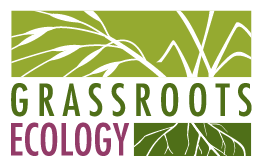Planting a Seed and Watching it Grow: the Impact of Environmental Education
By Devon Jackson, AmeriCorps WSP Member
I have come to believe that the strong emotional response some children have to the destruction of our environment is the way human beings of all ages should react. The beauty of children is that they have not been conditioned by society to rationalize the destruction of the natural systems we all depend upon. I think we can learn from their strong reactions. My work in the field of environmental education has led me to believe that we can achieve a better future, one where we live a more harmonious existence with nature and other human beings.
During my time in college I worked for a non-profit called Sprout Up that taught local first and second grade students about sustainability and environmental science. One of our activities was helping students design and construct a 3D habitat for a species of their choice. It was a beautiful experience watching children of differing ethnicities and socioeconomic backgrounds come together to achieve a common environmental goal, while laughing and playing with one another. It is rare to see adults reach across these kinds of dividing lines to achieve a common vision.
During this shared experience, my fellow instructors and I saw glimpses of a society where negative environmental externalities are not passed on to others just because they don’t live in an affluent neighborhood. All that mattered for the kids was solving the problem together. I hope these children will remember these moments when they are older and use what they learned to influence decision-making and fight for environmental justice in their community.
My time with the City of Santa Barbara as a Nature Camp counselor has also bolstered my faith in our youth’s ability to tackle future environmental problems. Each summer we took our campers to hear a variety of environmental presentations. One of my favorites was our talk on how we influence the quality of our fresh water. One of the most powerful moments I ever had at camp occurred after a presenter revealed to the kids how much freshwater we have available here on our planet.
She began by asking how much of the Earth’s surface is covered in water. The kids' responses would vary greatly before she revealed the final answer of 71%. Next she would ask how much of this 71% was available to us, including all the freshwater trapped in the polar ice caps. The counselors would usually whisper the answer to the nearest camper to help boost their self confidence. One of our littlest kids would usually shout out the answer of 3% despite the counselors reminding him or her to raise their hand. Finally, she asked how much of this 3% was not trapped in our polar ice caps, polluted, or too far underground for us to extract. Our presenter gave the kids a few guesses before revealing the final answer. She said 0.03% and this particular time the room went completely silent. You could tell the weight of this realization had struck home for all the kids.
As a result of this presentation, the students became very focused on figuring out ways they could individually improve water quality. It was particularly heartwarming to see them bring their own water bottles to camp and try their best to fill them up throughout the day. While some of these behaviors would be short-lived for most kids, my fellow staff and I hoped that this initial feeling of awe would lead to each kid thinking more rationally about our consumption of resources. Having a healthy respect for the limits of our environment can help instill a strong environmental ethic no matter what career one chooses to pursue. I believe that ultimately these kids’ actions early on in life will lead them to take more of a personal stake in the well-being of their communities, and spread hope for a better future to others.
After college I was blessed with the opportunity to be a Watershed Stewards Program (WSP) member at Grassroots Ecology. The WSP is an AmeriCorps program which aims to increase the health of waterways that contain salmon or trout. With Grassroots Ecology, I have been able to continue my work in environmental education in a new way. I get to work with youth volunteers to restore native habitat as well as teach lessons at local middle and high schools. This unique combination of hands on field work and in class lessons connects students with their local ecosystems, allowing them to better understand how to positively impact the environment. Whether we’re picking weeds or testing the water quality of local streams, I see hope and inspiration in local students as they work together to make Silicon Valley a better place to live for everyone.
Environmental education is one of the primary mechanisms through which we can open the hearts and minds of our youth to be invested in the long-term health of their community and planet. By planting the seeds of a strong environmental ethic, we help our youth to grow up to become drivers for sustainable growth and positive environmental change. Rather than continue the status quo, let’s chart a new path where the limits of our natural world are respected and all members of the community have access to a clean and prosperous environment.




